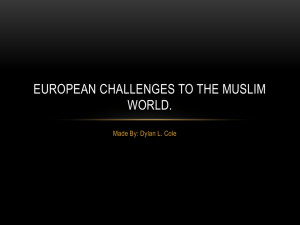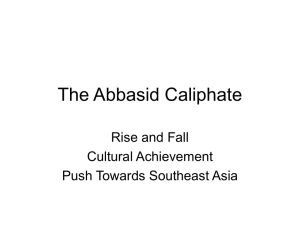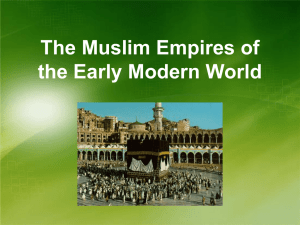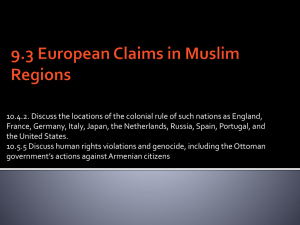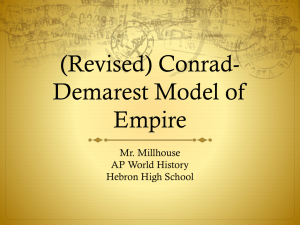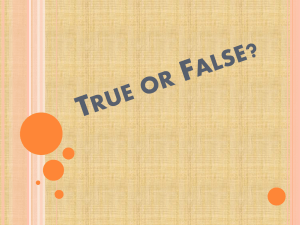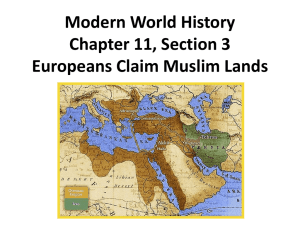Course outline 2 in MS Word format
advertisement
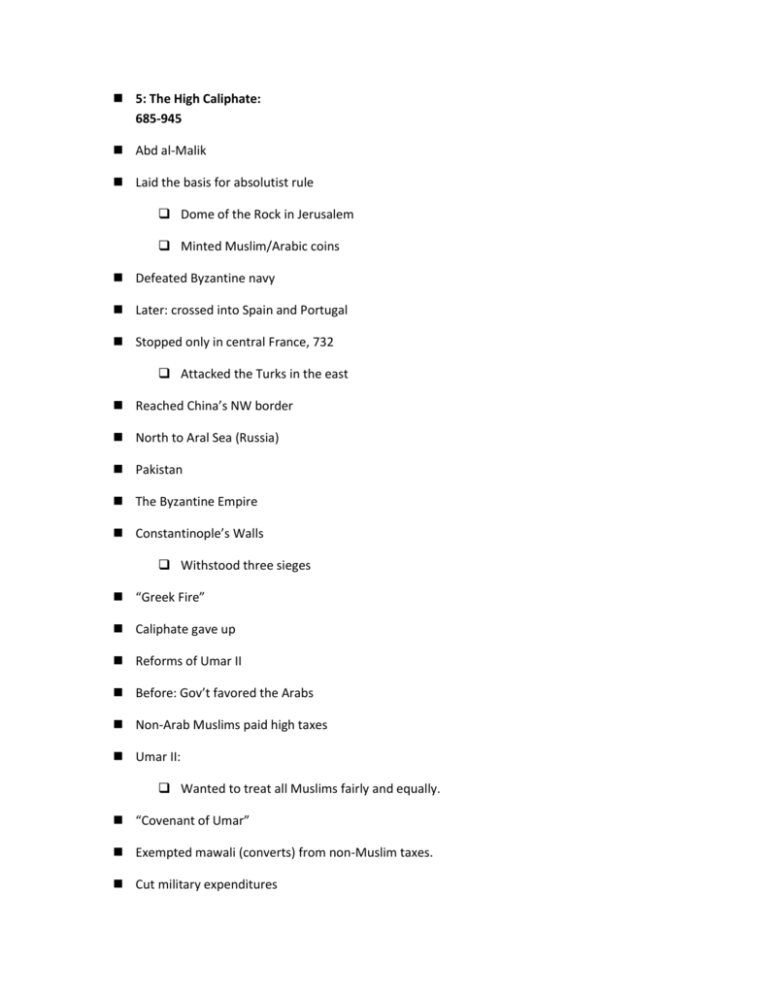
5: The High Caliphate: 685-945 Abd al-Malik Laid the basis for absolutist rule Dome of the Rock in Jerusalem Minted Muslim/Arabic coins Defeated Byzantine navy Later: crossed into Spain and Portugal Stopped only in central France, 732 Attacked the Turks in the east Reached China’s NW border North to Aral Sea (Russia) Pakistan The Byzantine Empire Constantinople’s Walls Withstood three sieges “Greek Fire” Caliphate gave up Reforms of Umar II Before: Gov’t favored the Arabs Non-Arab Muslims paid high taxes Umar II: Wanted to treat all Muslims fairly and equally. “Covenant of Umar” Exempted mawali (converts) from non-Muslim taxes. Cut military expenditures Put restrictions on non-Muslims The Fall of the Umayyads Popular discontent Arab tribes divided civil wars decadence of elites Revolts favoring the line of Abbas (Muhammad’s uncle) “Abbasids” Abu-Muslim Persian supporter of the Abbasids 750: Defeated the Umayyad army Killed the last caliph. Wiped out all the living Umayyads. Is killed during revolts. Results of fall of the Umayyads Replaced an Arab tribal aristocracy with a more egalitarian government based on principles of Islam. Shift of power from Syria to Iraq. Rise of Persian influence. Growing interest in the arts. Construction of Baghdad as capital. Persian Influence The caliphate is Persianized from within. By their harems– more Persian than Arab wives Persian bureaucratic families rose to power. Barmakids: Greatest of these. Viziers: High ranking ministers Mamun (7th Abbasid Caliph; reigned 813-833) Mother was a Persian slave girl. Defeated Arab half-brother for caliphate. Questioned some Muslim beliefs (p. 76) Decreed his own views (unpopular) “Mu’tazila” Mamun Sponsored search for new knowledge: Translations of Greek works envoys to Europe “House of Wisdom” astronomical observatory Decline of the Abbasids Continual revolts, 750-945 Revival of Byzantine Empire in 10th C. More Turks into service/ slaves/ army. Become strongest element in army. Took over the caliphate from within. 6: Shi’is and Turks, Crusaders and Mongols: The 10th-13th Centuries Shi’i Islam Believe Ali was Muhammad’s true successor Ali’s line inherited Muhammad’s “perfect” knowledge of the Quran Reject all other caliphs The Fatimid Caliphate A Shi’i dynasty Founder claimed descent from Fatima (M’s daughter) and Ali Wanted to overthrow Abbasid caliphate Captured Egypt, 969 founded Cairo Intellectual center; Al-Azhar (university) Mostly religious freedom to subjects Ruled Egypt for 2 centuries The Buyid Dynasty Captured Baghdad and the Abbasids in 945 Revived Persian sovereignty and culture The Buyid Dynasty Founded by 3 brothers, each with own capital Used the Abbasids as puppet rulers Allowed viziers to govern for them The Turks Probably from Central Asia Gradually became Muslim Slaves and soldiers for Islamic rulers 2. Seljuks: Attracted other tribes to join them Defeated the Ghaznavids Seljuk Turks Entered Baghdad to assist Abbasids “Sultan” (authority) Brought much land under Abbasid/Seljuk control Manzikert (1071) Took much of Anatolia “saviors of Islam” Empire crumbled by end of 12th Century Except for “Rum” Seljuk Legacies: Influx of Turkic tribes from Central Asia Turkification of Anatolia Restoration of Sunni rule in southwest Asia Spread of Persian institutions and culture Development of madrasa (mosque-school for Islamic law) Regularization of the iqta’ system for paying troops in land grants Weakening the Byzantines in Anatolia The Crusades Begin Seljuk threat to Byzantines– emperor asks Pope Urban II for help Pope agrees, for own reasons: Demonstrate the power of the papacy 2nd sons… Calls for Christians to liberate the Holy Land from the “wicked race” Early Successes Thousands of volunteers respond Joined with Byzantines in 1097 Took Antioch reached Jerusalem in 1099 Siege and bloodbath Some Europeans stayed and set up “Crusader colonies” Muslim Reactions Were fighting one another Lands being taken were mostly inhabited by Christians or Jews who supported the Crusaders Some Muslim rulers: alliances with Crusaders against rivals Second Crusade attacks Syria but fails Salah al-Din “Saladin” Revered as symbol of Muslim resistance to the Christian West Excellent general Defeated Crusader invasion of Egypt Declares himself sultan of Egypt Captured Jerusalem Fought Richard the Lion Heart at Acre, 1191 Used Turkic slave soldiers, “Mamluks,” in Egypt. Muslim militancy and intolerance grow in response to Crusades The Mongol Empire: The Mongols Related to the Turks 12th C: Jenghiz Khan united eastern tribes Attack Muslim armies in Central Asia Atrocities Pause in 1227 when Jenghiz Khan dies Grandson, Hulegu: Renews attacks on Islamic lands Rejects calls for alliance by Europeans Attacks Baghdad to destroy the Caliph (no rivals!) Mamluks Stop the Mongol Invasion Hulegu turns to conquer Egypt Called home due to succession issues Leaves reduced army near Egypt Mamluks (Egyptian, but ethnically Turk) Defeat Mongols in Palestine, 1260 Ended the Mongol threat to Islam Mamluks defeat Mongols, 1260 Hulegu and descendants settle in Iraq and Persia and adopt Islam! Mamluks drive last of Crusaders out, 1293 7: Islamic Civilization The Laws of Islam Shari’a Islamic law code Influenced by Roman and Persian law Sources: The Quran Muhammad’s practices (sunna) Analogy Consensus of the umma Judicial opinion Shi’i legal systems: The imams can interpret the law Judges But no lawyers, prosecutors, or district attorneys Islamic Society Social groupings Islam stressed equality, But class structures survived from earlier times Ruler and subject Subjects: nomads and settled peoples Ancestry, race, religion, sex Arabs were favored Early converts over later ones Christians and Jews had fewer rights Women had different responsibilities Family Life Family played central role Marriages arranged by parents Preferably between cousins— Keep property intact Men were allowed four wives But few could afford this Divorce easier for men Close and intense family ties Intellectual Life Arabs preserved classical Greek knowledge for later revival in the West Advances in math Algebra, geometry, decimals, etc Arabic numerals Hindu invention, spread to West by Arabs Geography, astronomy Literature: Arab, then Persian, then Turkish Poetry Prose and fables; The Arabian Nights Architecture Especially large mosques Theology Mu’tazila People are responsible for their own acts Use of reason Hanbal Predestination Divine revelation is a better guide to the Quran than reason View of the Quran is similar to Christians’ view of Jesus: The means by which to know God. Sufism: “Organized Muslim mysticism” Seek to uncover hidden meanings Meditation, fasting, other rites Enabled Islam to absorb some customs of converts from other religions. 8: Firearms, Slaves, and Empires Mamluks 250 years in power Control of main trade routes to East Military based on slaves Decline around 1500 Greed, Black Death, failure to use firearms The Mongol Il-Khanids Descended from Hulegu Settled in Tabriz, Azerbaijan Intermarried and became Muslims Introduced some Chinese influences into Persian art and architecture Written histories and poetry with Persian flavor Tamerlane Led army of Muslim Turks Sought to create vast empire Capital at Samarqand Conquered parts of Persia, Russia, India, and Turkey Slaughtered thousands Died suddenly in 1405, before he could invade China Most lands then won back independence quickly The Ottoman Empire Venetians occupied Constantinople, 1204-1262 Weakened Byzantine power Osman I Turkish warrior chief Conquers some Byzantine territories for Islam & Turks By 1354, Turks on European side of the city 1395: European multi-national army is defeated by Ottomans in the Balkans Setback— Tamerlane nearly destroys the Ottomans around 1402 Mehmet I rebuilds the empire Mehmet II: conquers Constantinople itself in 1453. Uses cannons “End of the World” to Europe! “Istanbul” Soon it is richer than ever Selim I: Ottoman Empire--greatest since the caliphate. Firearms and disciplined troops Defeated the Mamluks Captured Arab heartland Suleyman the Magnificent Greatest of the Ottoman sultans Revamped the government and laws Causes of Success “Just and brave” rulers New sultans put their brothers (rivals) to death Rewards based on ability Schools for government service Europeans in the empire free from obeying Ottoman laws and local taxes Decline Besieged Vienna in 1683, but repelled. By 1699: on defensive. One army, inflexible. Economic conditions deteriorated. Europe exploiting New World Sea routes Family ties and favoritism Safavid Persia The Safavids Turkish Shi’ites Conquered Persia— Converted them to Shi’ism. Isfahan 10: European Interests and Imperialism Ottoman Empire at its height: Ottoman Weakness Sultans lost interest: in maintaining their empire In defending the lands Wealth, harems, wine and hashish Internal revolts Failure to use new weapons Growth of superstition and ignorance Oblivious to growth of knowledge in Europe The Eastern Question: “Will Russia take the Ottoman lands?” The West: surpassed the Muslim world in the 1700s. Rise of Tsarist Russia A growing empire “The Third Rome” Seeking ice-free ports Desire access to Black Sea Russia Fought the Ottomans five times in the 1800s. Opposed by the major European powers. Feared Russian disruption of the “balance of power” Austria Annexed Ottoman lands in the Balkan Peninsula, as the Ottomans lost control of them. Bosnia. Russian expansion to east: Russia, Balkan Peninsula, Black Sea, etc Britain Sides with the Ottomans in the 1830s: Trade deals Mutual suspicion of Russia Crimean War: Britain with the Ottomans, against Russia. Troops to Afghanistan to counter the Russians. France: Close ally of the Ottoman Turks Both were opposed to Austria Involvement in Syria and Lebanon Maronite Christians– close with France Napoleon invades Egypt in 1798 Suez Canal Built by France; opened in 1869. Opposed by the British, who then mostly took it over. France colonizes most of North Africa
